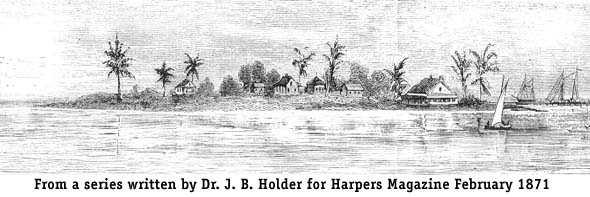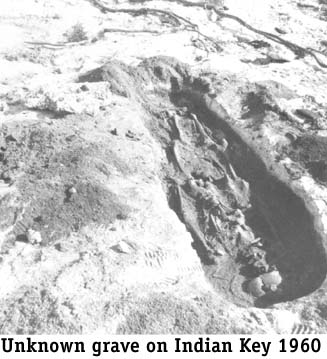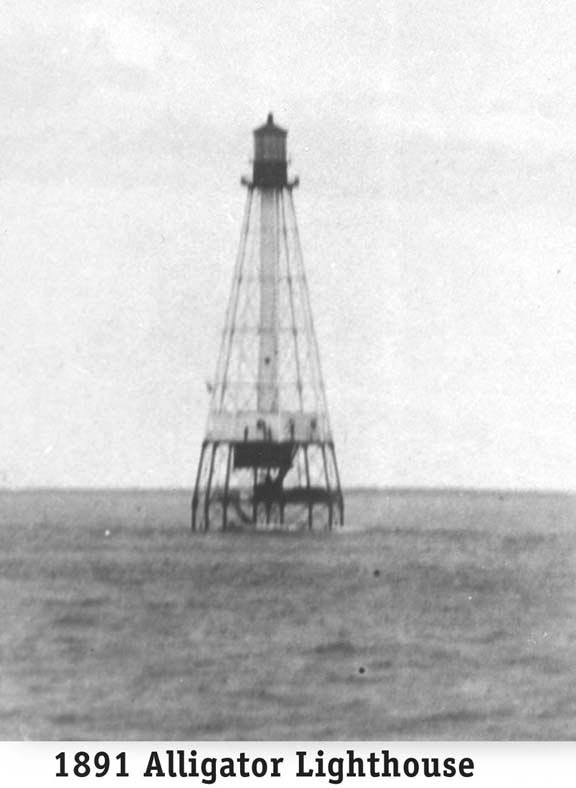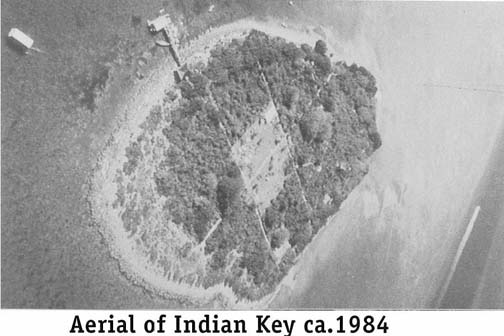|
The following is a view of the Indian Key that encompasses more than
the
sensationalism of wreckers and Indians, the before and after vis-a-vis
the reign of Jacob Housman from 1830 to 1840. Indian Key is critical to
the history of the Upper Keys. It was its first settlement, became the
county seat for Dade County, served various transitory functions, then
fell into relative obscurity after the 1935 hurricane. Today it is a
state
park.
To set the stage for Indian Key, a little chronology will be repeated.
In 1821, Congress approved Florida as a U.S. Territory and on March 25
of 1822, Lt. M. C. Perry took physical possession of Key West. He
planted
the U.S. flag to prevent another disagreement over whether or not the
Keys
were a part of Florida.
The following year, Commodore David Porter was sent to clear the waters
of pirates so U.S. shipping could proceed in peace. On March 3, 1825
Congress
passed the Federal Wrecking Act prescribing that all property in these
seas must be brought to a U.S. port of entry. In 1828 the U.S.
established
a superior court in Key West with admiralty jurisdiction. The only
other
east coast court was at St. Augustine, so most of the Florida Keys
wrecking
property was taken to Key West.
Now to Indian Key. Exactly how and when the name originated is
debatable.
The Key's harbor was probably used first as an anchoring location for
early
ships to obtain fresh water located on Lower Matecumbe Key. Its name
does
not seem to appear on early charts. In 1742 Liguera shows it as Cayuelo
de las Matanzas (slaughters). The Alana chart of 1743 shows Cayo
Frances
(French). The DeBrahm chart in 1772 shows it as Matance (slaughter).
Then
in 1774, George Gauld quotes Captain Barton, a mid-1700s English sailor
referring to it as "Frenchman's Kay." In New Orleans while researching
the French connection with Indian Key, I came across the following
story,
but no documentation. Perhaps the Internet can assist us.
"Story: The French were needing laborers in today's
Louisiana/Mississippi
area. Someone raided the French prisons and loaded the prisoners aboard
a ship/s. Somewhere in the Keys waters the ship/s wrecked and the
Indians
killed all of crew and passengers. Since the act had the sanction of
the
Crown and all were killed, the entire act was 'covered up' or not
recorded.
Enough of this event got out to cause the island to be named on some
maps
as Franses (the county of France), Frenchmen's or Matanzas (slaughter)
Key."
Anyway, Indian Key was not part of the Spanish land grant properties,
therefore
immediately became U.S. public property in 1821. It was in 1830 that
Congress
established "the pre-emptive right on all public lands." If executed
correctly,
legal land title could be obtained under the pre-emptive rights law
after
official state surveying. For Indian Key, official land survrying was
done
in 1872. In other words, the "pre-emptive rights" pre-empted any and
all
other claims. No one did this for Indian Key, yet the Island's settlers
exchanged fully recorded land deeds back and forth until 1910.
Since the first federal census was not until 1830, we do not have a
definite
picture of Indian Key's original inhabitants, but the following is a
summary
based on early Key West court records. Silas Fletcher settled on Indian
Key in April 1824 to sell goods to mariners for Solomon Snyder and
Joshua
Appleby of Key Vaca. It was decided to build a house and a store, for
which,
a Joseph Prince was hired as an assistant. Silas, his wife Avis, and
two
children, William and Abigail, used the house.
Evidently, Silas and Prince formed a partnership and purchased the
holdings
of Snyder and Appleby in January 1825. For reasons unknown, Joe Prince
decided to leave a few months later (May) and according to Silas
Fletcher,
Joe Prince sold to him his half of the partnership's business
interests.
Later Silas purchased from Prince the building that housed the
store.
Silas did not have a commercial monopoly for long, as Joe Prince
returned
in 1826 and opened a competing store. This indicated that there was
enough
business on Indian Key for two stores. Remember that all of this
happened
some 65 years before Miami was incorporated. Key West was incorporated
in 1828 and had a U.S. Superior Court. Silas Fletcher sold all his
Indian
Key property to Thomas Gibson for $2,500 and departed Indian Key in
1826.
All of these property transactions are recorded in Monroe County Deed
Books
A, B and C in Key West. No other island name other than Indian Key is
mentioned.
Prince and Gibson are shown in the 1830 census, and Fletcher is not, as
should be.

Concerning Indian Key, Dr. J. B. Holder writing for Harper's
Magazine
in 1871 wrote " Indian Key is one of the few islands of the Reef that
can
be called inhabited. Here for many years the wreckers have resorted, as
it is convenient as a midway station and the safest harbor in heavy
weather...."
It is thought that by 1829 the island's population was around 50
people,
mostly transient fishermen, turtlers and wreckers. Enter Jacob Housman
of Key West, who was sold a building by William Johnson in November
1830,
then a store and a building by Thomas and Ann Gibson in July of 1831.
Supposedly,
Housman wished to break away from the control of those in power at Key
West.
The story of Jacob Housman's reign at Indian Key from 1830 to 1840, and
its finale with the massacre, has been told and retold many times. This
period is the primary focus of most short story writers. The following
is a summary of the major events of that period.
Somehow, in the early 1820s John Jacob Housman obtained his father's
sailboat
and set sail for Key West from Staten Island, New York. He ran aground
before reaching his goal and was personally indoctrinated into the
Keys'
wrecking industry, in which he became immediately interested. While in
Key West he learned the intricacies of the wrecking business.
In the year 1825, as a Key West based wrecker, Housman transported the
goods from the French ship Revenge on Carysfort reef to St.
Augustine,
where he persuaded the court to award him a 95 percent salvage award.
The
award was hotly contested by the French consul and reduced to
two-thirds.
After encounters with his associates and the wrecking courts, Housman
began
looking into establishing a more favorable port of entry, an admiralty
court and a customs house. This led to his additional 1831 purchases on
Indian Key of a two-story house, a store, a 9-pin bowling alley,
billiard
room, guest house and kitchen from Thomas and Ann Gibson for $5,000.00.
Housman then proceeded with additional purchases to set up a
mini-empire
under his control.
Just what role Housman had in establishing a new county is not recorded
very well. The facts go like this. Monroe County's own Territorial
Representative,
Richard Fitzpatrick, divided it into two counties on February 4, 1836.
Therefore, a new Florida county was created from the east part of
Monroe
County beginning just north of the western end of Bahia Honda Key. The
name Dade was given to the new county in honor of Major Francis Dade,
who
was killed at the onset of the Second Seminole War near Bushnell,
Florida.
Indian Key was designated the temporary county seat of Dade County. The
Middle and Upper Keys remained part of Dade County until the counties'
present boundaries were established in 1866.
Research of public records for the Middle and Upper Keys from 1836 to
1866
must be derived from Dade County records. This was one reason I chose
the
census of 1870 as my reference census. Middle and Upper Keys residents
during 1840, 1850 and 1860 were included in the Dade County census and
generally were not separated from the mainland population.
The tensions of the Second Seminole War were felt in the Keys. In
January
1836, Indians attacked the Cooley family in present-day Fort Lauderdale
and burned the Cape Florida lighthouse on Key Biscayne. On June 28,
1837,
Captain Whalton of the Carysfort lightship, "Florida," and one
of
his crewmen were killed on Key Largo. Frequent sightings of camp fires
at night were attributed to the presence of Indians.
Housman took almost immediate action to protect his investment. He
established
Company B, 10th Regiment Florida Militia with himself as commander and
a cadre of 38 men including 6 slaves. The pay was 30 cents a day plus
50
cents a day for rations. The militia was disbanded in 1838 when
relieved
by Captain Rudolph of the Cutter Dexter. Housman later made a
claim
for the expenses incurred for the militia.
Meanwhile, Dr. Henry Perrine while U.S. Consul in Mexico had been
sending
experimental plants to the Keys area and formed the Tropical Plant
Company.
Upon returning from Mexico the doctor had been warned of the Indian
unrest
in Florida; however, he went to Indian Key in December of 1838 anyway.
He used a two-story house of Charles Howe for his family and base of
operations.
He proceeded with his agricultural plans almost as if no hostilities
with
the Native Americans existed.
On March 16, 1840, a Mr. Downing presented to the governor and
legislative
council of Florida Jacob Housman's proposition to catch, or kill, all
the
Indians of South Florida for $200 each. (See the Journal of the House
of
Representatives, Monday, March 16, 1840, page 612.) Action on the
proposal
was referred to the committee of military affairs. Whether the above
had
any adverse effect or not is conjecture.
Early in the morning of August 7, 1840, Indian Key was attacked by a
large party
of Indians. It is a long story, but in summary on
August 6, 1840, Lt. Rodgers departed neighboring Tea Table Key for the
west coast of Florida with all military personnel capable of service.
This left only the civilians on the island as the defenders. At about 2
A.M. on August 7, Chief Chekika and his group of warriors landed on the
west coast
of the Key and were shortly discovered. Taken by surprise, the
residents
either fled or were killed and most of the island burned.
According to the August 29, 1840 issue of the Niles National Register,
". . . The following persons were on the key at the attack: Mr.
Houseman[sic]
and wife, Mr. Chas. Howe, wife and 5 children, Dr. Perrine, wife and 3
children Mrs Elliott Smith, child brother and mother, Mr. Goodhue,
clerk
of Mr. Houseman's, 8 men, crew of the wrecking sloop Key West, and some
10 or 12 negroes, the latter all saved. Out of this number Mr. Motte,
wife
and two children, are destroyed, and Dr. Perrine and the brother of
Mrs.
Smith, with all the houses except one of Mr. Howe's. . . ."
Housman escaped, but his Indian Key empire was in ashes. Housman made a
government claim for $114,630 contending that he had operated a naval
depot
which the government failed to protect and he personally paid for a
company of Florida
militia for which he was not reimbursed; therefore the government was
liable.
After his death in Key West on May 1, 1841, Mrs. Housman could not
prove
her marriage and was refused her claim as executrix of the estate.
Housman's
father Abraham became administrator. He entered a plausible lawsuit
with
19 affidavits from people who allegedly witnessed the incidents. The
case
went to the U.S. Senate Committee on Claims who agreed that Housman's
warehouse
had indeed been used by the Navy for storage and the Navy had left the
island unprotected.

Be that as it may, in 1848, the committee on claims once and forever
denied
all the Housman claims stating that he was "a mere tenant at sufferance
of the United States." In other words, all this time "they were all
squatters
on public domain," and ". . . had no real rights there whatsoever." It
further stated that if he had chosen to contract and "store goods which
attracted the cupidity and other passions of the Indians . . . it was
his
risk and not that of the United States."
After the 1840 massacre, the Florida Squadron of the Navy moved to
Indian
Key, but only stayed there until the end of the Second Seminole War in
1842. The 10.4-acre island was sold at public auction January 15, 1844
to Messrs. Mowry and Lawton, mortgage holders from Charleston, S.C. The
Great Hurricane of 1846 did considerable damage to the structures that
the Navy had left. (Indian Key had been lucky as from 1820 until 1846
no
significant storms had made contact.) W. H. Hilliard is thought to have
operated some kind of a store after the hurricane. Hilliard acted as
the
agent to lease the island to the U.S. Army Corps of Topographical
Engineers
for 15 months at $20 a month for the construction of the Carysfort
Lighthouse.
George Meade revealed the negotiation in his letter of June 30, 1851.
Indian
Key itself had been suggested for the location of a lighthouse at one
time.
In January of 1852, Joseph Lawton sold his rights to Indian Key,
including
the Hilliard store, to Smith Mowry. Mr. Hilliard served as Lawton's
agent
for Indian Key for some time. A letter from William H. Bethel dated
March
10, 1856 (during the Third Seminole War) to Mowry reveals Mr. Bethel
living
on the Key alone. He and the owner Mowry petitioned for troops to be
sent
to protect the island against the Indians so Bethel could move his
family
there from Key West. Bethel was deeded Lignumvitae Key in 1881. Bethel
evidently also acted in the capacity of Inspector of Customs.
A military garrison was sent to Indian Key in 1856 because of concerns
of Indians seen in the surrounding areas. This was the time period of
the
Third Seminole War. Mowry indicated that he owned 24 or 25 houses on
the
Key and he feared that they would be burned. These were offered for use
by the military.
The present Upper and Middle Keys, including Indian Key, became a part
of Monroe County again in 1866. Two companies of the 3rd Artillery were
sent to Indian Key for a short stay again in 1869.
Between 1868 and 1875 records indicate three ships were registered in
Key
West that were built at Indian Key. The first was the 34 feet long, 11
ton schooner Emma registered in 1868 with J. Fernandez as
master.
Second was the 33 feet long, 10-ton schooner Euphemia
registered
in 1873 with George Bartlum as master. Third was the 37 feet long,
13-ton
schooner Clyde registered with Agustas Sands as master. This
would
have been the period that the aforementioned Dr. Holder passed through
in 1871. Indian Key did not disappear after the massacre of 1840.

Indian Key once again became involved with the lighthouse service when
it was used as a depot to store and pre-assemble the Alligator Reef
lighthouse
from late 1870 to 1873. In 1876 Henry Perrine Jr. revisited Indian Key
for an hour. He commented that "There are perhaps half dozen common
dwelling
houses scattered about the central portion of the Key." In 1885 bananas
valued at $8,000 were shipped by the Pinder families from Indian Key.
The
Pinders were probably living on Upper Matecumbe Key by then as their
homestead
had been proven by 1885.
Newspaper accounts reveal that Henry Flagler used Indian Key to support
his dredging operations in the middle Upper Keys. It was especially
important
during the early construction of the Indian Key Fill causeway. The
island
and it wharves were used to support dredge operations.
Another unidentified, but dated September 11, 1909, clipping reads:
"The
extension well at Indian Key water station is now down ninety feet. The
Messrs. Walker, who have charge of putting down this well are
determined
to make a record. Twelve-inch casing is being supplied from the Long
Key
machine shops." Fresh water of sufficient quality was not found and the
well opening used to be near the southwest corner of the townsite
square.
Flagler eventually bought Indian Key from the state, but had the land
patent
issued to Elizabeth H. Smith of Duval County, Florida. The patent is
dated
June 30, 1909 but was not filed until October 16, 1913, six months
after
Flagler's death.
At the time of the 1935 hurricane, two unemployed telegraph operators
were
using Indian Key as a fishing location. The Miami Herald of September
4,
1935 gave their names as Lee Colter and Bill Hanlan. After the
hurricane,
one was found draped over a cistern with a broken back and the other
was
reportedly found drowned on Lignumvitae Key. In 1971, the State bought
the Key and designated it a historic site. The saga continues as
historic
groups attempt preservation and restoration.
The complete history of Indian Key, a small but populated island half
way
between Key West and Miami (Fort Dallas), is much more detailed than
the
above. It is interwoven with the history of wrecking, orchestrated by a
character named Jacob Housman at its peak, and its most famous event
occurred
during the Second Seminole War. With the public records divided by
Monroe
and Dade Counties and the massacre finale of burning almost everything
up to 1840, its historical facts, legends and sensationalism's are
difficult
to separate. However, with the time and effort of researching the
archival
records and the writings of the Perrine children and others, its
history
can be approached. However, as with Herrera and Fontaneda, many of the
comprehensive writings were made many years after the event. For
reasons
of space, only the principal data has been presented here.
-----End-----
|


